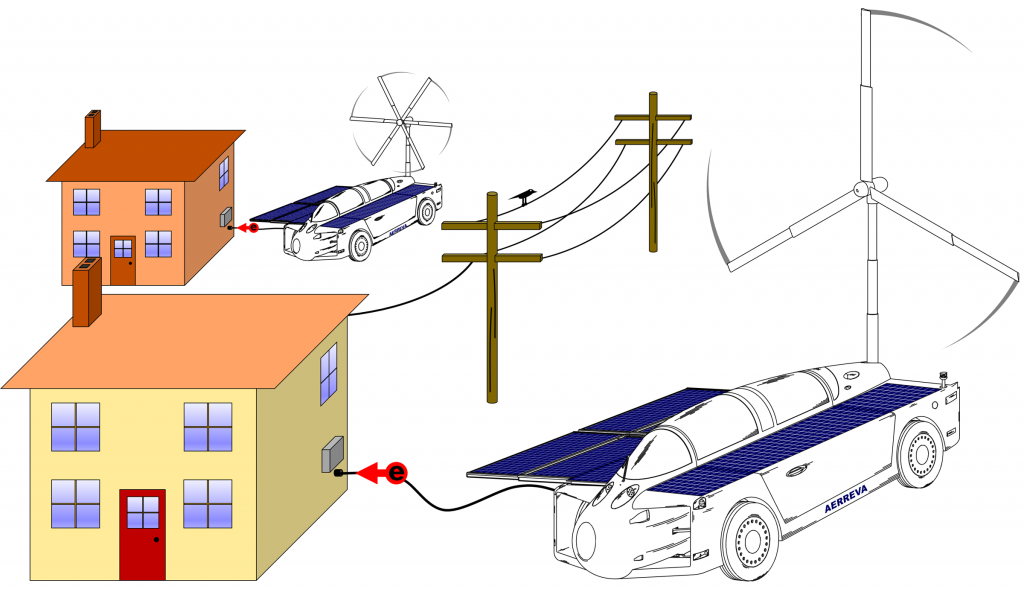
AERREVA H-Series
Primary Energy Sources
Abstract
All-electric vehicles (EVs) and internal combustion engine (ICE) vehicles both rely on non-renewable primary energy sources for operation. While gasoline and diesel fuels used by ICE vehicles are refined from crude oil and other liquids, electricity for EVs is generated mostly from natural gas, coal, and nuclear power.
Barring new major discoveries, conventional global reserves of these energy sources is estimated to last another 57, 49, 139, and 90 years, respectively, based on present consumption rates. As these reserves diminish and extraction becomes more challenging, energy production will shift towards unconventional sources such as oil shale and tar sands. At present, in the U.S., 60% of oil imports currently come from Canadian tar sands. Extracting oil from tar sands is significantly more energy-intensive than conventional methods, with average energy returns on investment (EROI) of around 4:1, which produces more emissions than conventional methods, and also poses significant risks of polluting ground and surface water with toxic runoff and waste.
When comparing motor efficiencies, EV motors are significantly more efficient than gasoline or diesel engines. However, generating electricity for EVs is inefficient and environmentally harmful. Approximately 60% of the energy used to produce electricity is lost as waste heat in the power plants, rather than being converted into usable electricity. When considering the full fuel cycle (FFC) of grid electricity, including losses during AC to DC conversion while charging batteries, the overall efficiency of both propulsion methods converges to around 20-30%. While grid-connected solar and wind energy systems are renewable and sustainable sources, they depend on weather conditions, which significantly affect their energy production throughout the day. To maintain a constant and reliable power supply, these intermittent sources frequently rely on fossil-fueled power plants, which have to ramp up or down their output in order to balance energy production fluctuations thereby further reducing power plant efficiency. The decline of viable primary energy sources will have repercussions not just for transportation but for civilization as a whole. There is an urgent need to develop an environmentally sustainable society that utilizes vehicles powered by clean, sustainable energy, independent of the electrical grid or fossil fuels. This approach is essential for fostering a sustainable energy future.
Sustainable Transportation Solutions
Introducing AERREVA, an innovative self-charging all-electric vehicle concept (SC-EV) that is specifically designed to maximize solar and wind energy for its charging requirements. Unlike the integration of solar and wind power into the U.S. power grid, which poses significant challenges, primarily due to the consistent high demand for electricity from both residential and commercial sectors, electric vehicles remain stationary approximately 95% of the time, which provides a large window for AERREVA vehicles to engage in charging throughout most of the day through their novel onboard energy generation systems. AERREVA vehicles are equipped with a retractable solar panel array that effectively tracks the sun and a wind-tracking horizontal axis wind turbine (HAWT) fitted with an extendable tower subsystem.
Sun-tracking solar panels generate significantly more energy than stationary panels, particularly in the northern hemisphere. The turbine subsystem features a telescoping tower and extendable blades, allowing the rotor diameter to double in size. This capability enables the turbine to produce approximately four times the wind energy compared to its stowed position.
When not on the road, these subsystems can be activated automatically when favorable weather conditions are detected or safely stowed during adverse conditions, such as hail, extreme winds, or ice. Any surplus energy generated each day can be used to supply electricity to a home. Through net metering, homeowners can reduce their utility bills and earn renewable energy credits, which can range from approximately $100 to $500 per month, depending on electricity rates and weather conditions.
While small wind turbines may generate less power than larger ones, they offer several advantages. One significant benefit is that small turbines can be directly connected to battery chargers, significantly reducing transmission losses that typically occur when electricity is sent over long distances from wind farms to consumers. Additionally, small turbines are easier and more cost-effective to maintain, as large wind farms are often located in remote areas.
For example, replacing a single blade on a large wind turbine can cost around $300,000, while a gearbox replacement can exceed $500,000. In contrast, smaller turbines can be installed much closer together, optimizing space and efficiency. Large turbines necessitate up to 80 acres each to minimize interference from neighboring units. Additionally, smaller turbines operate at a lower blade tip speed—around 100 mph versus 180 mph for larger models. This lower speed significantly reduces the risks associated with issues like leading edge erosion, blade detachment, delamination, and structural failures caused by collisions with birds, and other airborne debris.
AERREVA’s design includes a central battery compartment and tandem seating that enhance stability and handling while providing robust protection for both passengers and batteries. Housed in a removable tray at the rear of the vehicle that doubles as both seat and chassis support, this system accommodates a variety of battery types, including lithium-ion, absorbent glass mat, and lead-acid batteries—each of which offers distinct recycling benefits.
The patent-pending AERREVA H-Series includes several models designed for different operating environments, with energy production estimates available on the solar and wind energy pages. Additionally, the new V-Series, which features a different type of wind turbine suitable for areas with shifting winds, is currently under development alongside other series.
The H-Series combines various configurations of wind turbines and solar panels. The horizontal axis wind turbine (HAWT) can be paired with either a tiltable solar array (T) or a non-tiltable solar array (S). The number of blades on the turbine rotor can be configured to optimize performance for locations that have different wind conditions. More blades generate greater torque in low wind conditions, while configurations with fewer blades, such as the two- and three-blade versions, perform better in high wind conditions.
Configurations with even blade counts (2, 4, and 6) can be efficiently stored in the vehicle’s rear section, while the three-blade model (3H), which has the largest rotor diameter, has a dedicated stowing area. Additionally, a tracking solar array is most effective in regions with low sun angles, while a non-tilting solar array can work in areas with high levels of sunlight, such as regions near the equator.
The various H-Series HAWT configurations include:
-TH: Tracking solar array and an even number of turbine blades.
-SH: Extendable non-tracking solar array and an even number of turbine blades.
-T3H: Tracking solar array and a three-blade large turbine.
-S3H: Extendable non-tracking solar array and a three-blade large turbine.
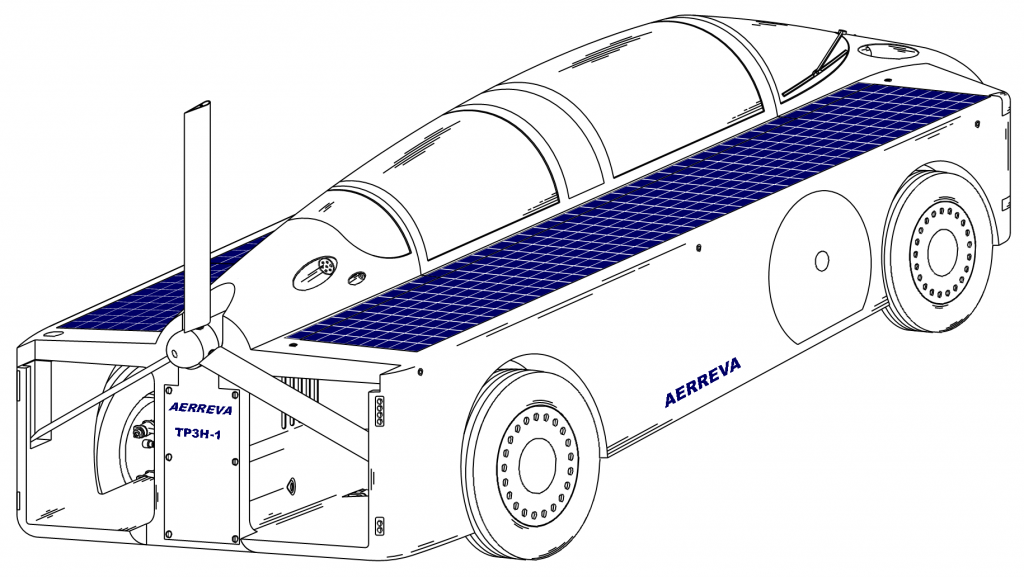
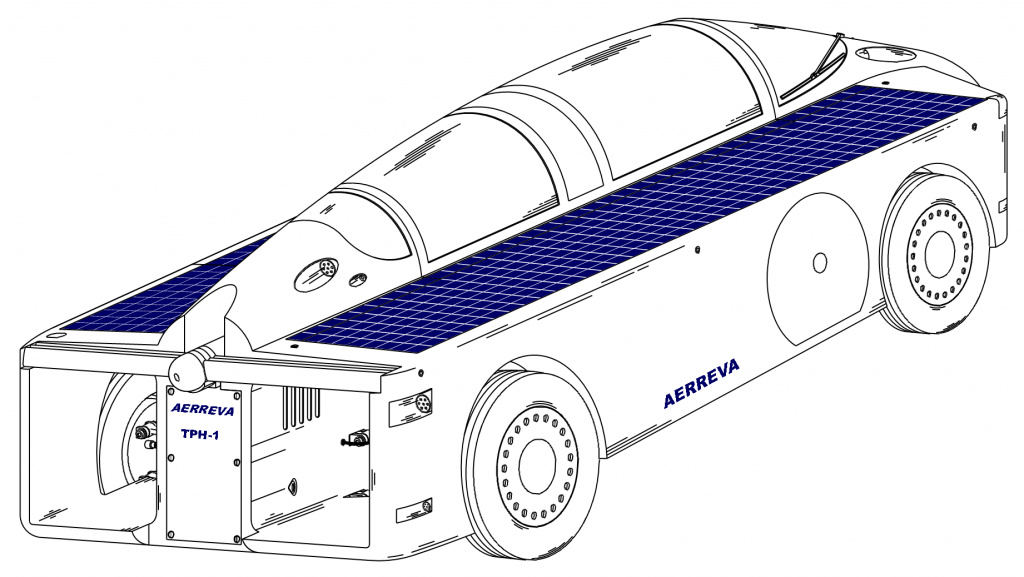
Features
The AERREVA H-Series vehicle features a centrally positioned cabin that enhances visibility, handling, and safety. Its lightweight design and small frontal surface area all contribute to higher efficiency. The battery pack, located at the center, is removable for maintenance or battery replacement. Additional features include large bypass air channels that improve aerodynamics, an extendable horizontal axis wind turbine subsystem, and a top-side solar array for charging while in motion, along with a retractable solar array subsystem. The design incorporates sloped top-side decks that facilitate rainwater runoff, an extendable anemometer for measuring wind speed and direction, and a large cabin door for easy entry and exit.
For versatility, the vehicle provides removable overhead canopies for open-air driving or emergency exits. It also includes a radiator to cool the battery pack, dampers to cool the solar cells to enhance efficiency, and all-around crumple zones for occupant protection. The seats can be easily removed, and the wide body design ensures stability while accommodating large solar and wind turbine subsystems. Additionally, most suspension components are shielded from the airstream. For safety and convenience, the vehicle is equipped with side and rearview cameras and features a spare tire stored in an outer wall compartment.
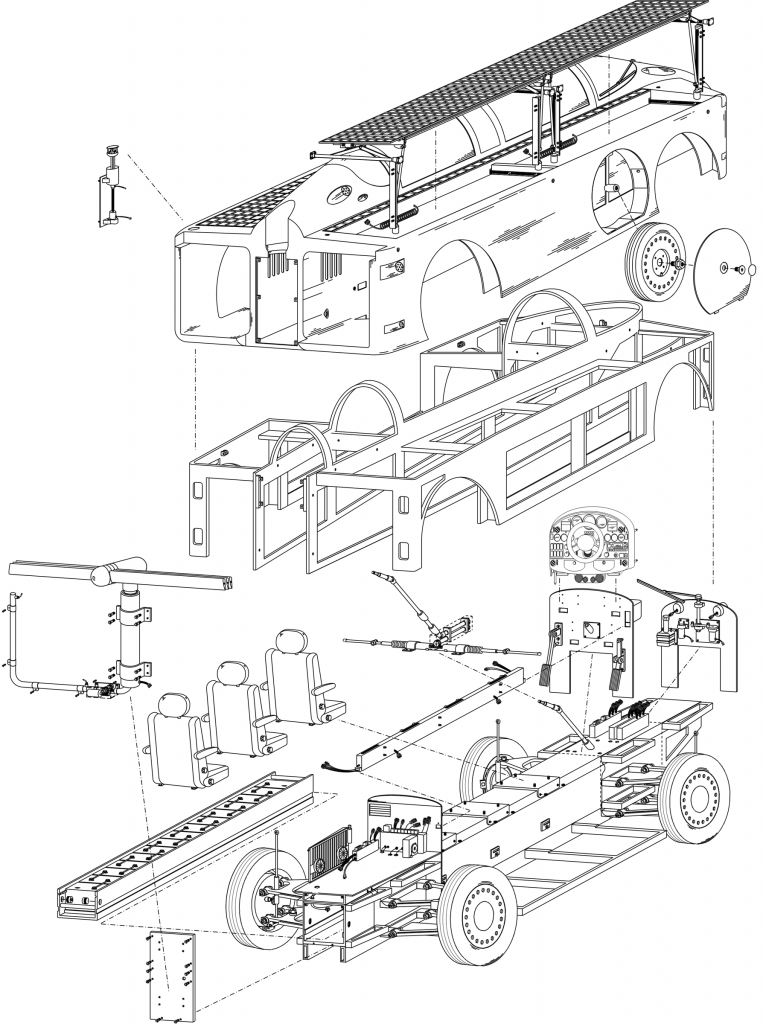
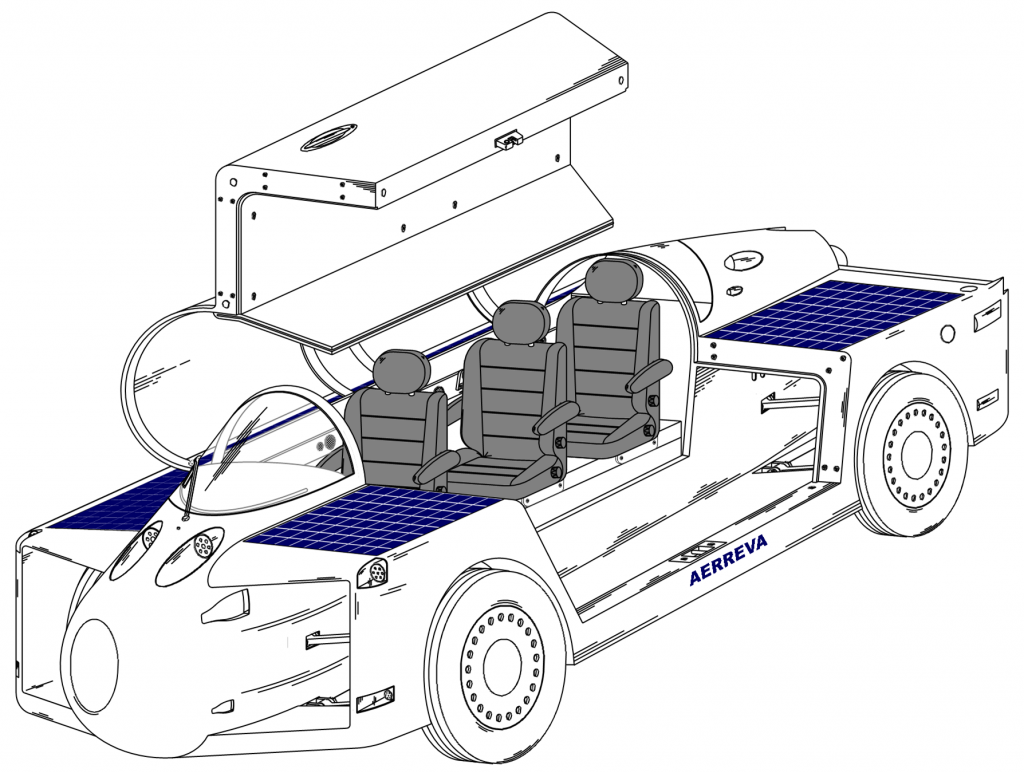
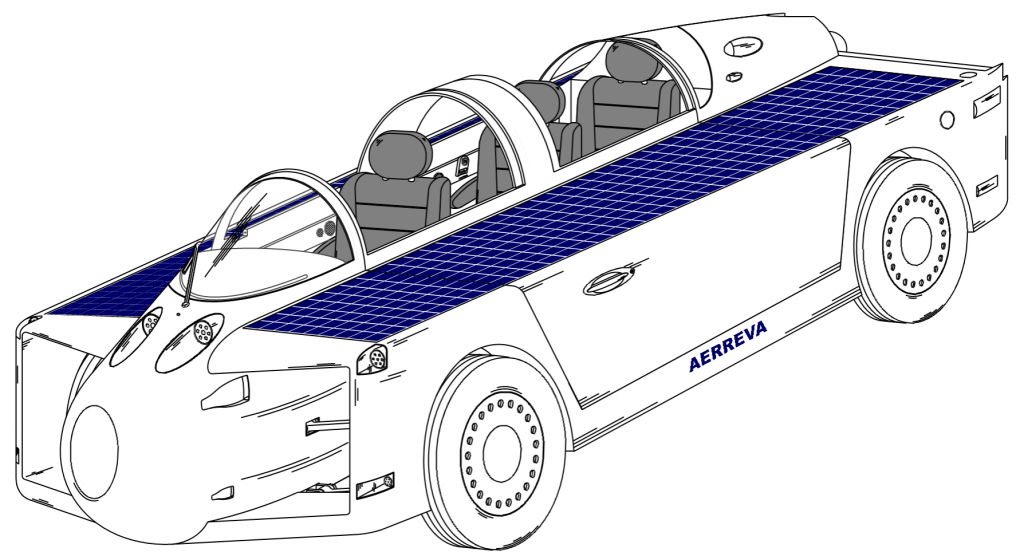
Battery Options
The battery pack, positioned centrally beneath the seats, is safeguarded by belly panels and chassis rails. It is compatible with various battery types, including Lithium-ion and Absorbent Glass Mat (AGM). The estimated range is 1,885 km (1,171 miles) for Lithium-ion batteries and 311 km (193 miles) for AGM batteries. Larger battery packs can extend the range but also add weight, which in turn increases rolling resistance. While lead-acid batteries perform better in subzero conditions, they provide less than a quarter of the energy (measured in Watt Hours per Kilogram) compared to Lithium-ion batteries.
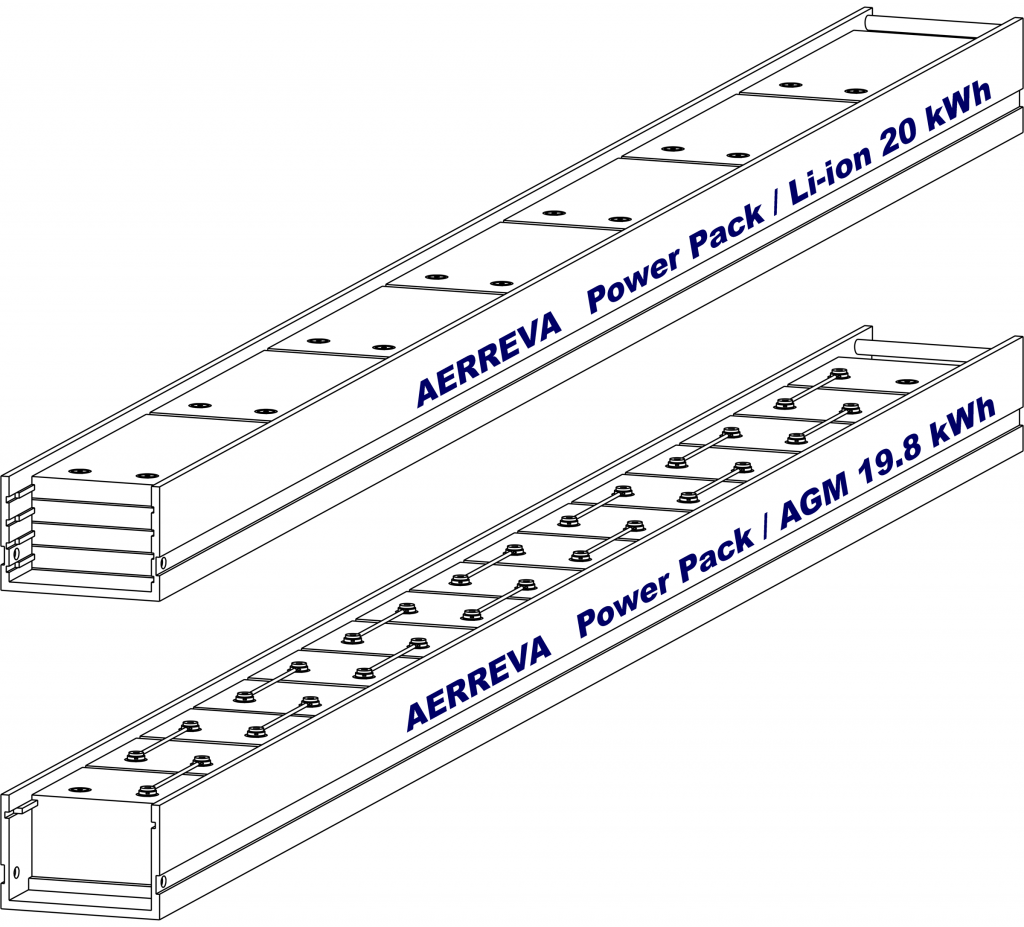
Lithium-ion and Absorbent Glass Mat (AGM) Battery Pack Options
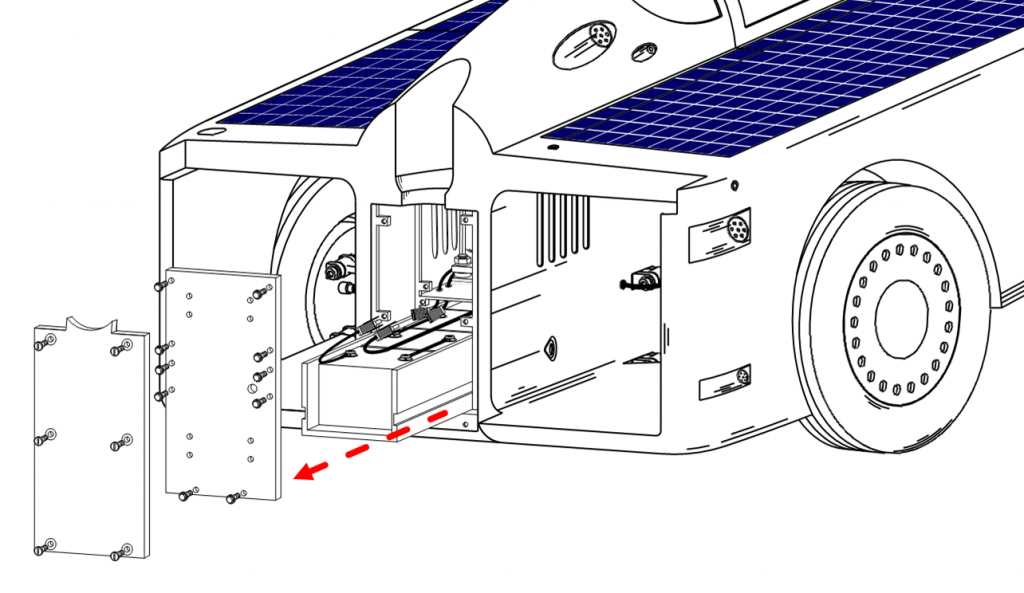
Battery Pack Removal
Generating Solar Energy
When the Sun sensor detects favorable conditions, it activates the solar array subsystem while parked.
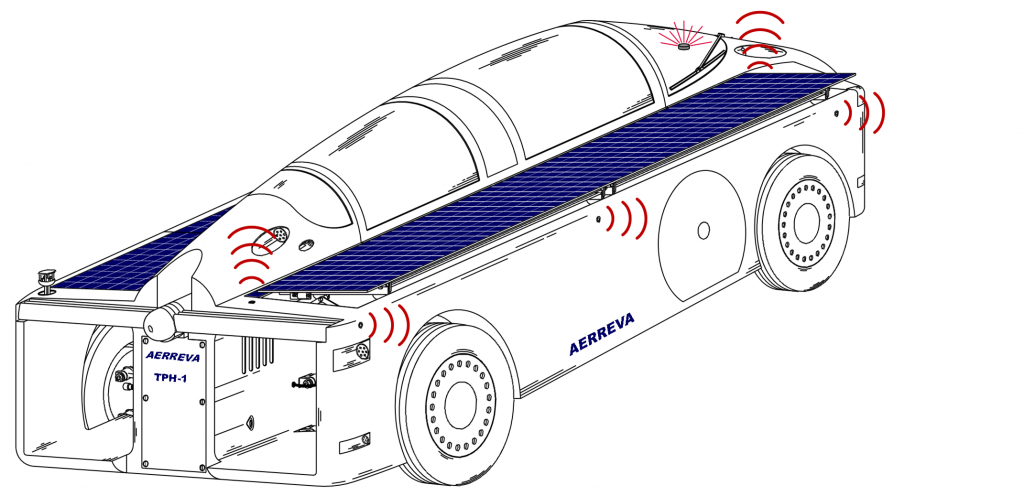
Once any obstructions are scanned, the solar array is activated.
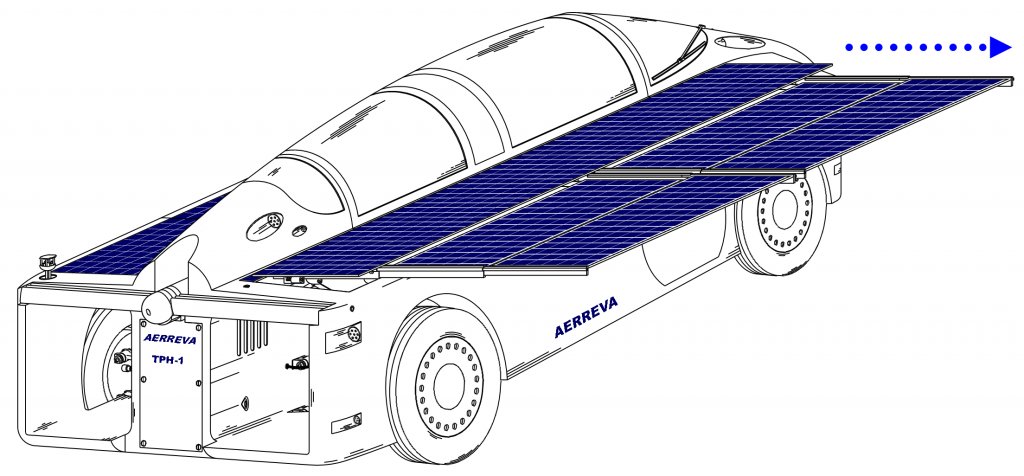
The solar panels are being extended.
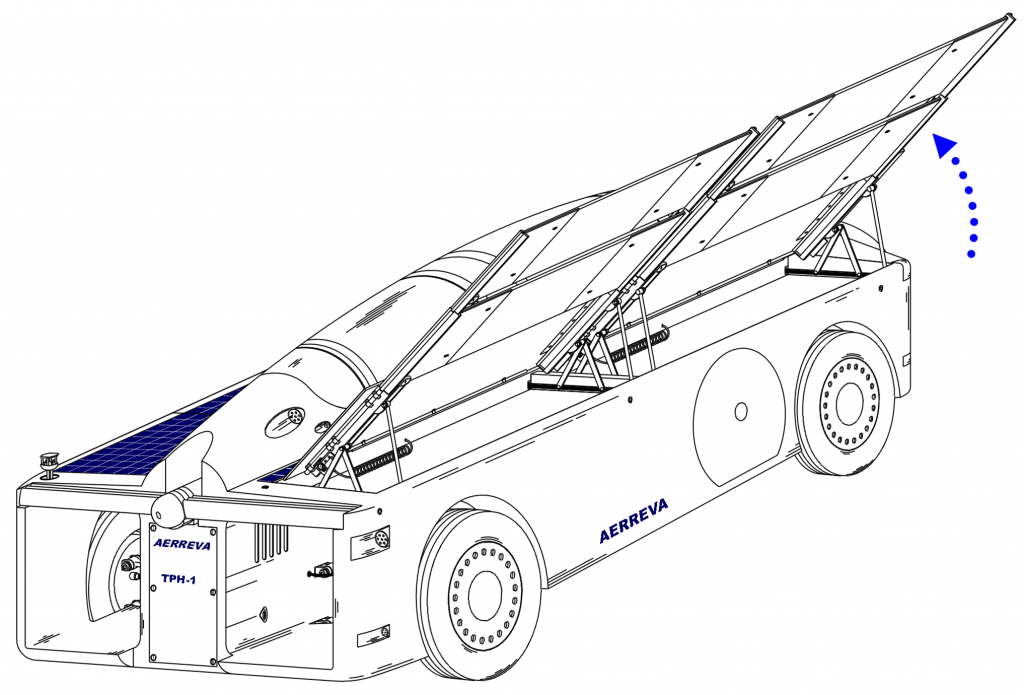
The solar array has the capability to be tilted upwards.
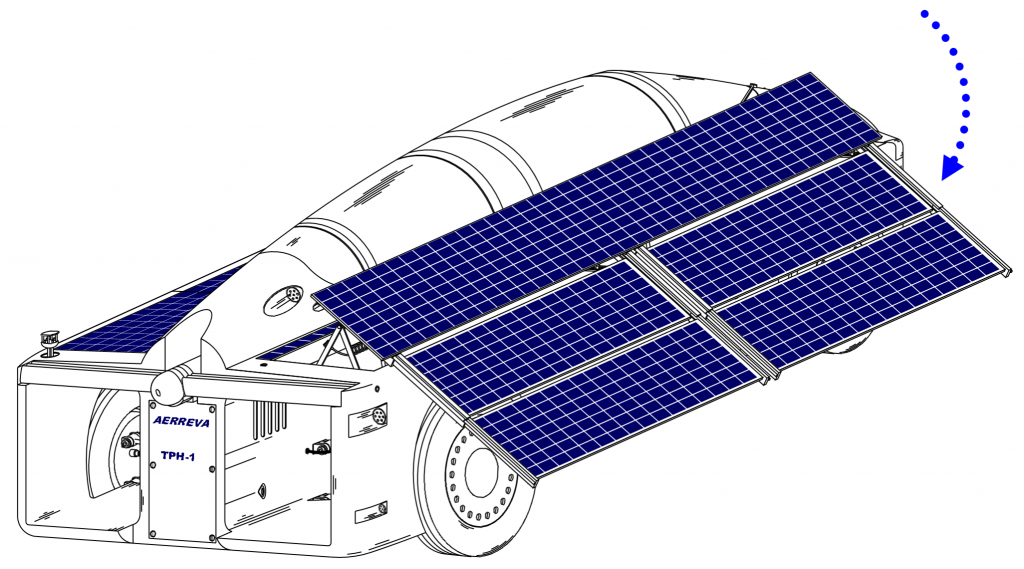
Or angled downwards.
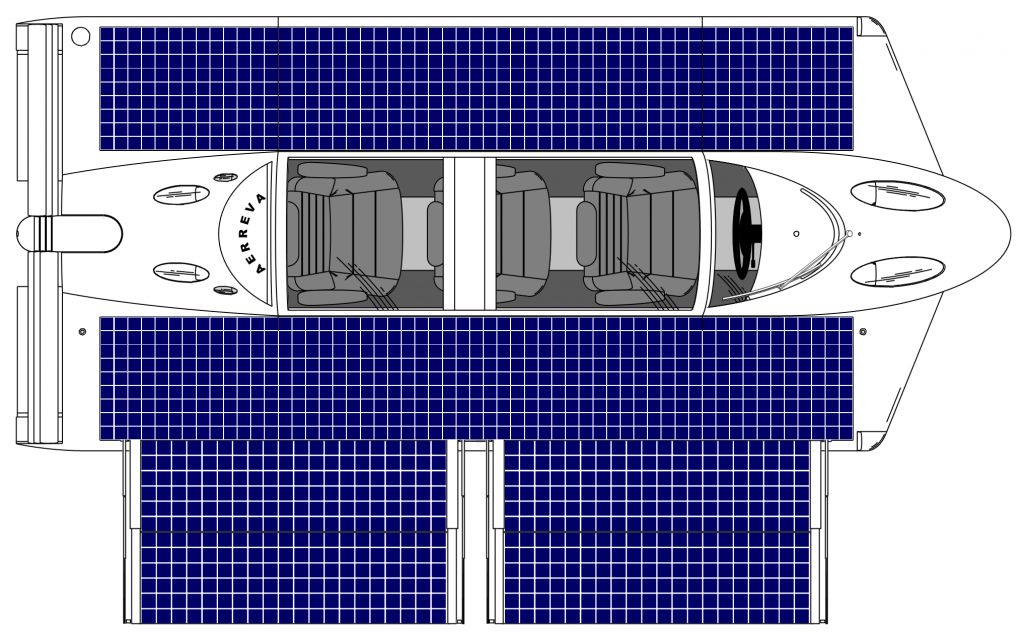
Solar Array Capacity
The energy produced by solar cells is influenced by several factors, including the Sun’s strength and angle, air quality, and the efficiency of the solar cells. At sea level, the Sun’s energy density is approximately 1,000 watts per square meter. Solar cells with an efficiency of 22% can generate up to 220 watts per square meter. When all the solar arrays are combined and positioned horizontally, they can produce a total of 1,512 watts, equivalent to 7.56 kilowatt-hours (kWh) in a single day. This amount of energy can power the EV for daily trips of around 60 miles, assuming an energy consumption of approximately 6.714 kWh, or 122 watt-hours per mile, at a speed of 55 mph.
Additionally, using tracking systems can more than double energy production, particularly during winter months when the angle of the Sun is lower. The production estimates are based on an average of 5 kWh of solar energy per square meter, as indicated by solar energy maps from the U.S. DOE, National Renewable Energy Laboratory. The amount of solar energy varies by region, with Southwestern states receiving more energy per day compared to the Northeastern parts of the U.S.
Generating Wind Energy
The vehicle’s wind turbine subsystem includes a telescoping mast and a rotor with extendable blades that can be stored in the rear section. An ultrasonic wind anemometer measures wind speed, duration, and direction to activate the turbine when favorable winds are detected while the vehicle is parked. The horizontal-axis wind turbine (HAWT) can be configured with either an even number of blades (2, 4, or 6) or a 3-blade version, which is the largest in the H-Series and produces the highest power output. Turbines with more blades provide greater torque in low wind conditions, whereas those with fewer blades enhance flow speed and perform better in high wind situations. When the vehicle is parked, the various HAWT subsystems can be activated if favorable wind conditions are detected.
3 Blade HAWT
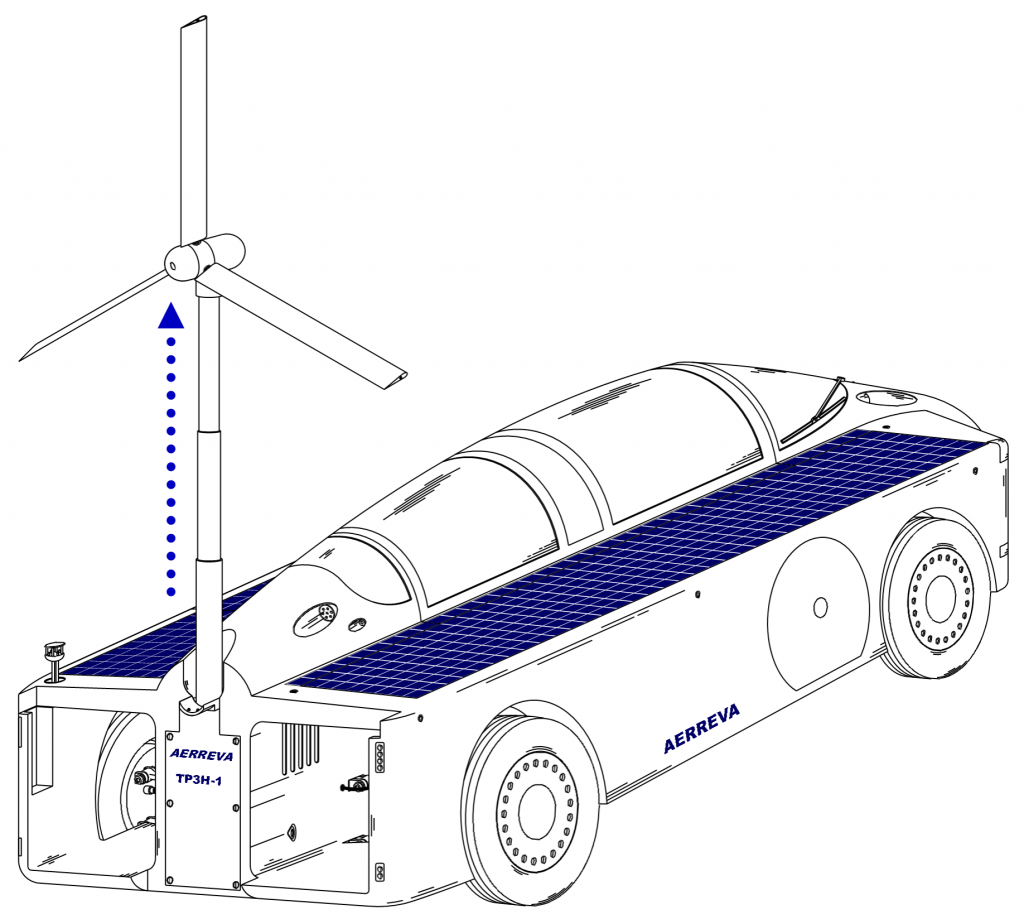
The tower is extended.
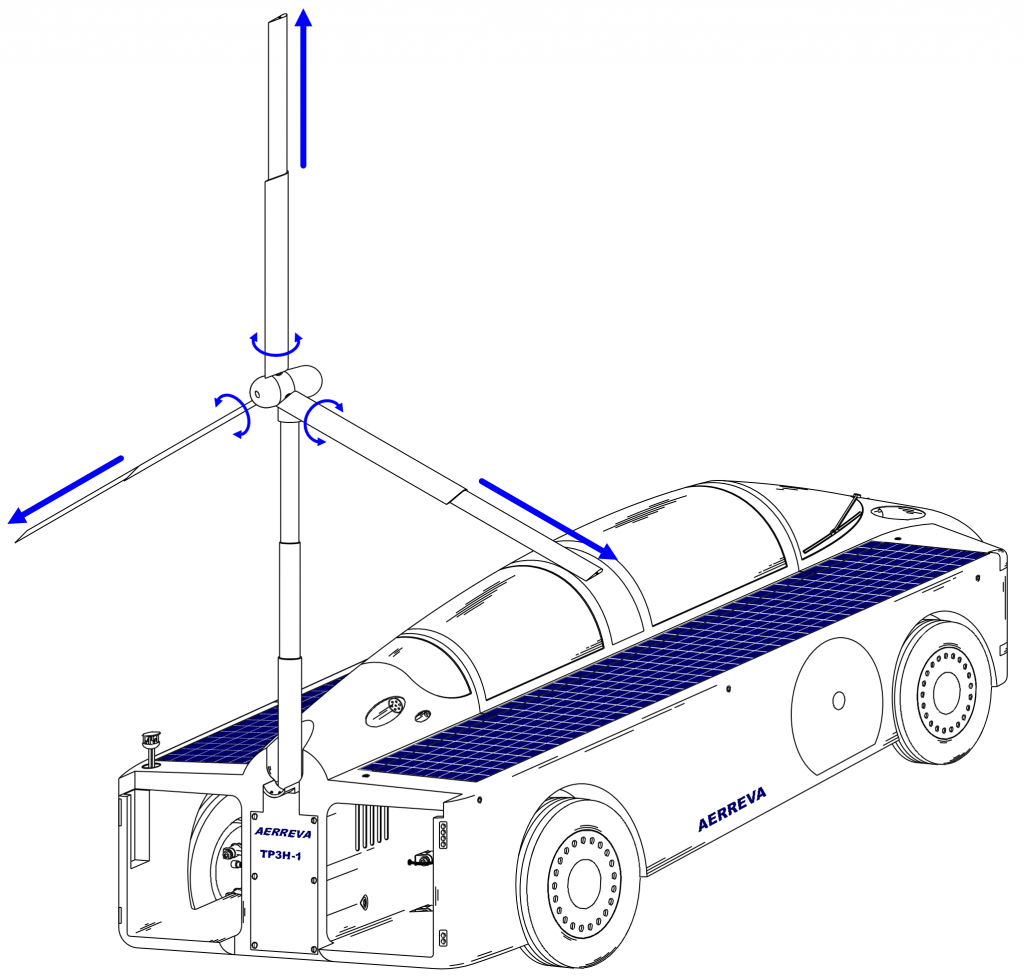
The blades have been extended and rotated from their feathered position.
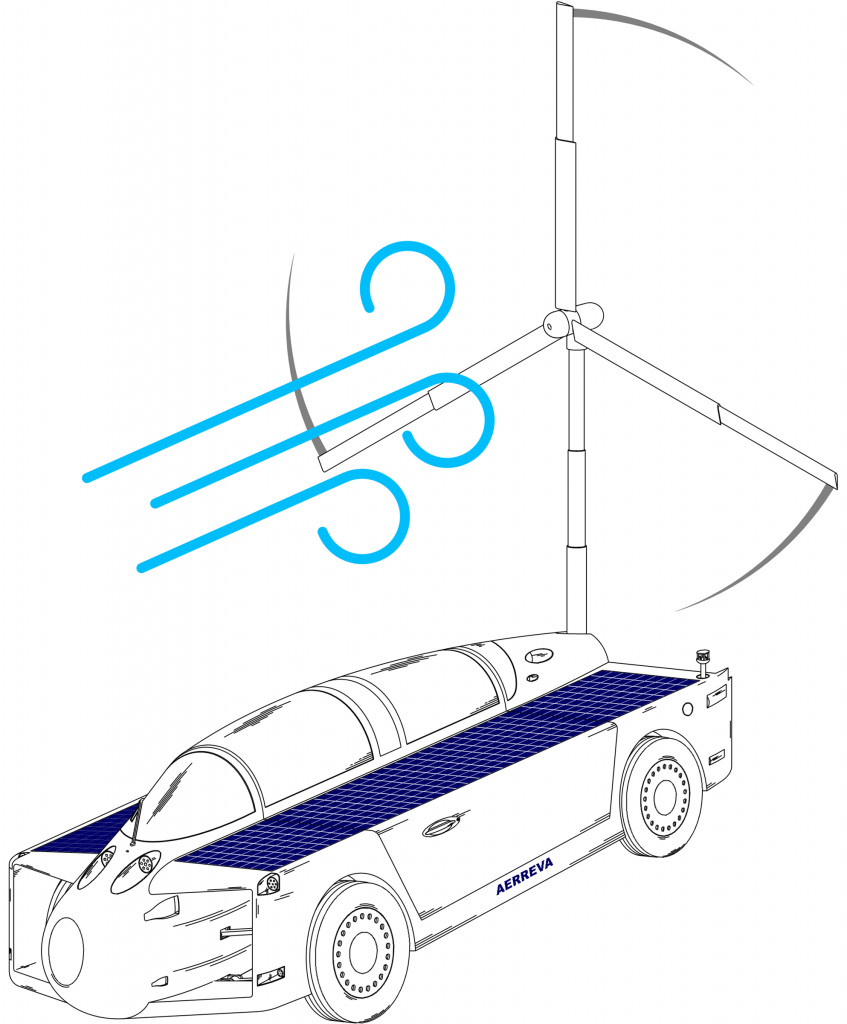
The turbine is rotated to face the wind.
6 Blade HAWT
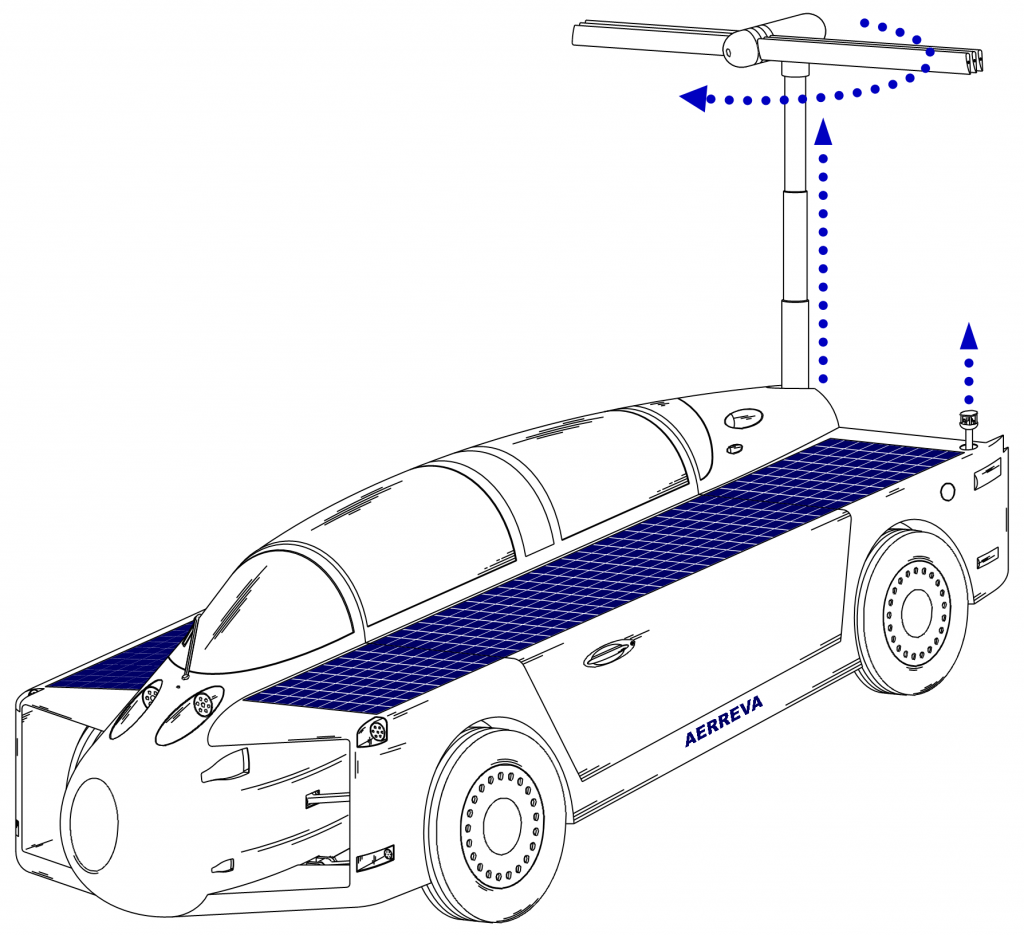
The tower has been extended and the turbine has been rotated to face the wind.
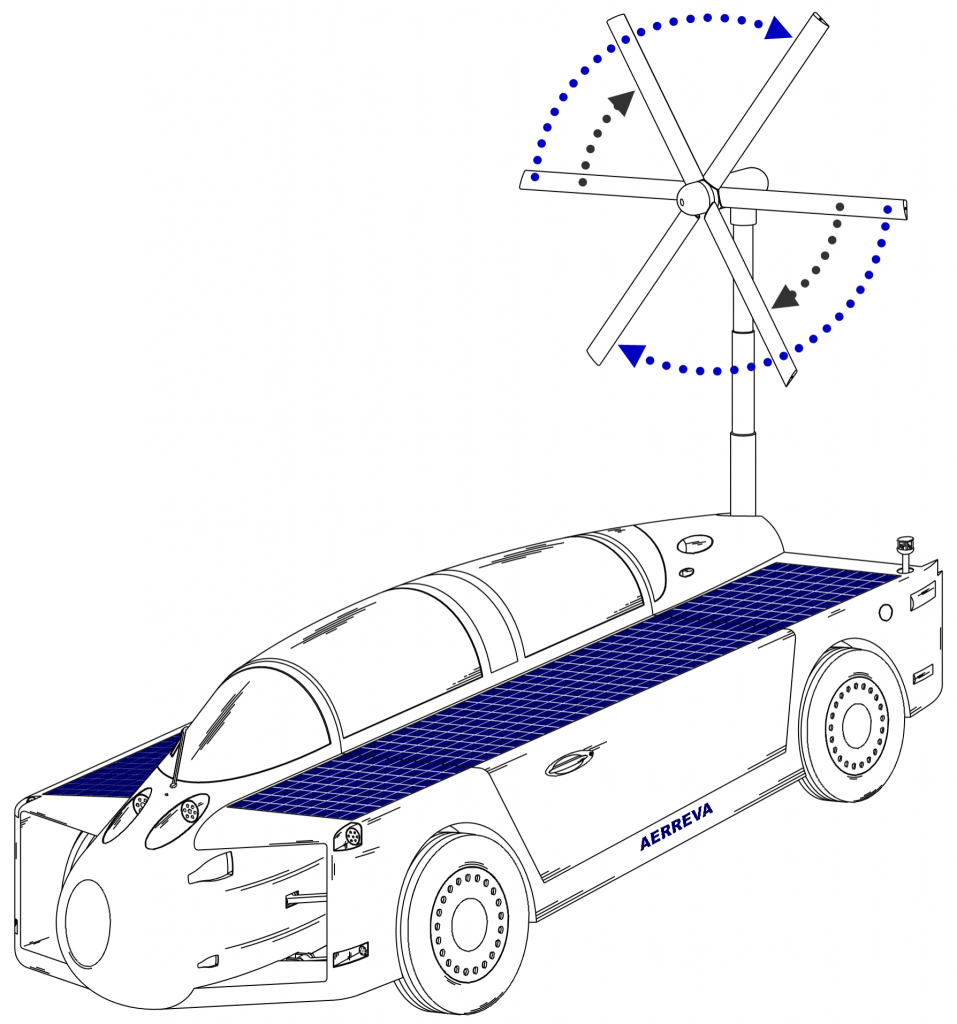
The hubs can be rotated and then locked into place.
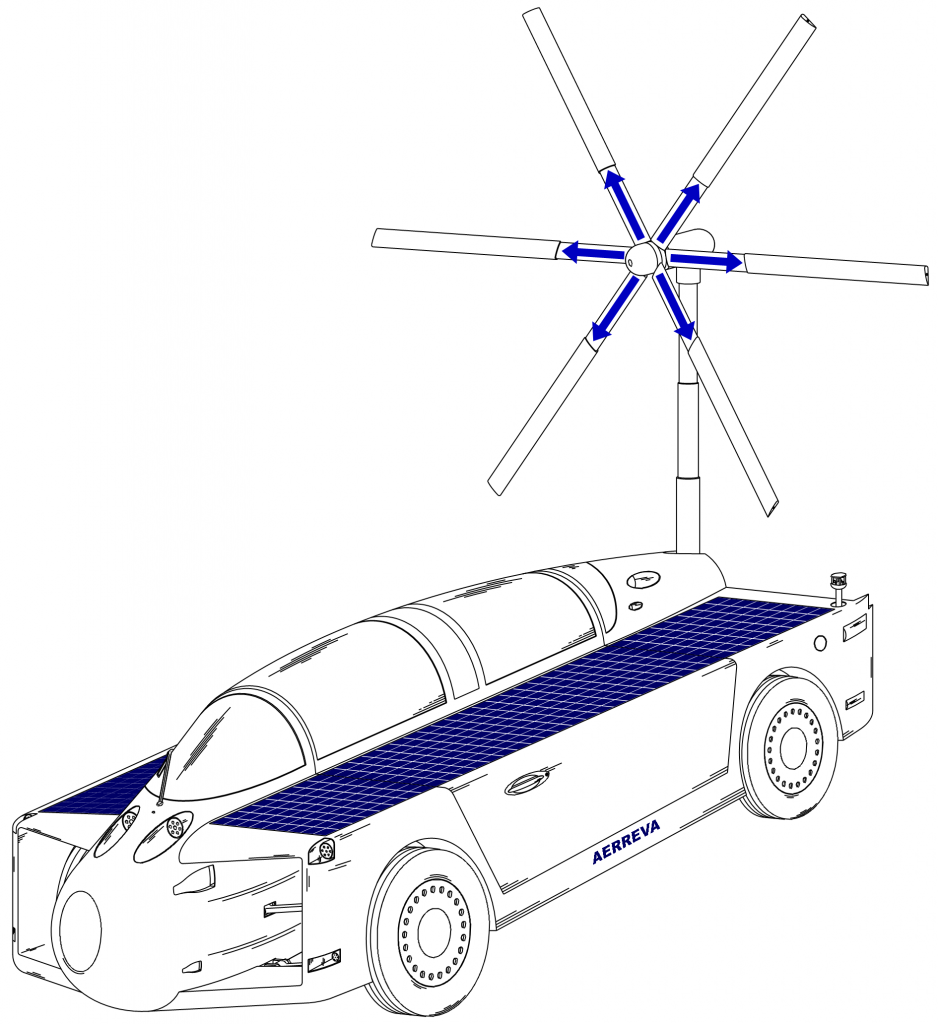
Blades are extended.
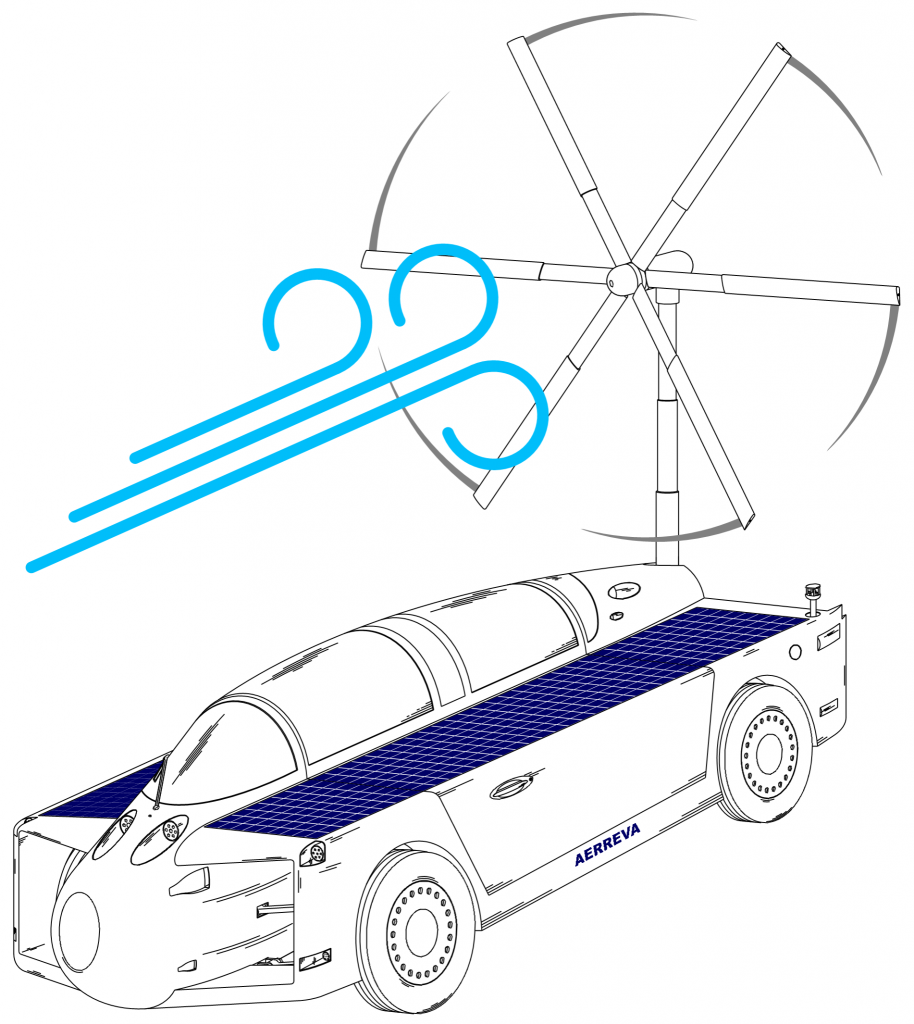
Wind turbine is fully deployed
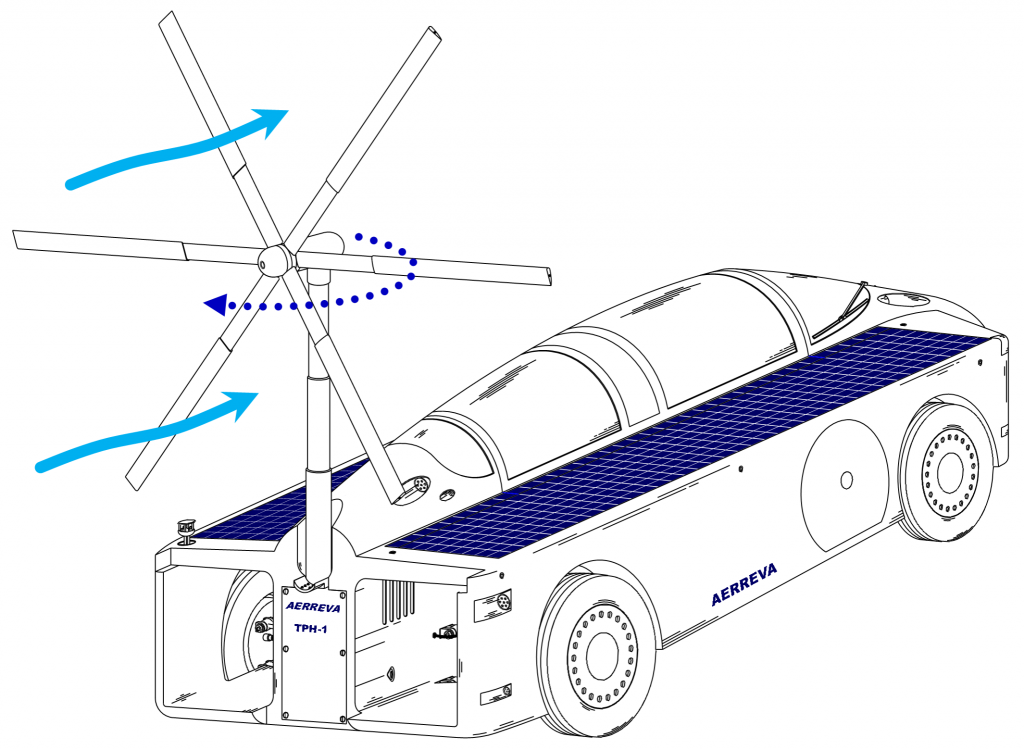
The turbine is designed to rotate in order to follow the direction of the wind.
The other blade configurations, a 4-blade, are not currently displayed.
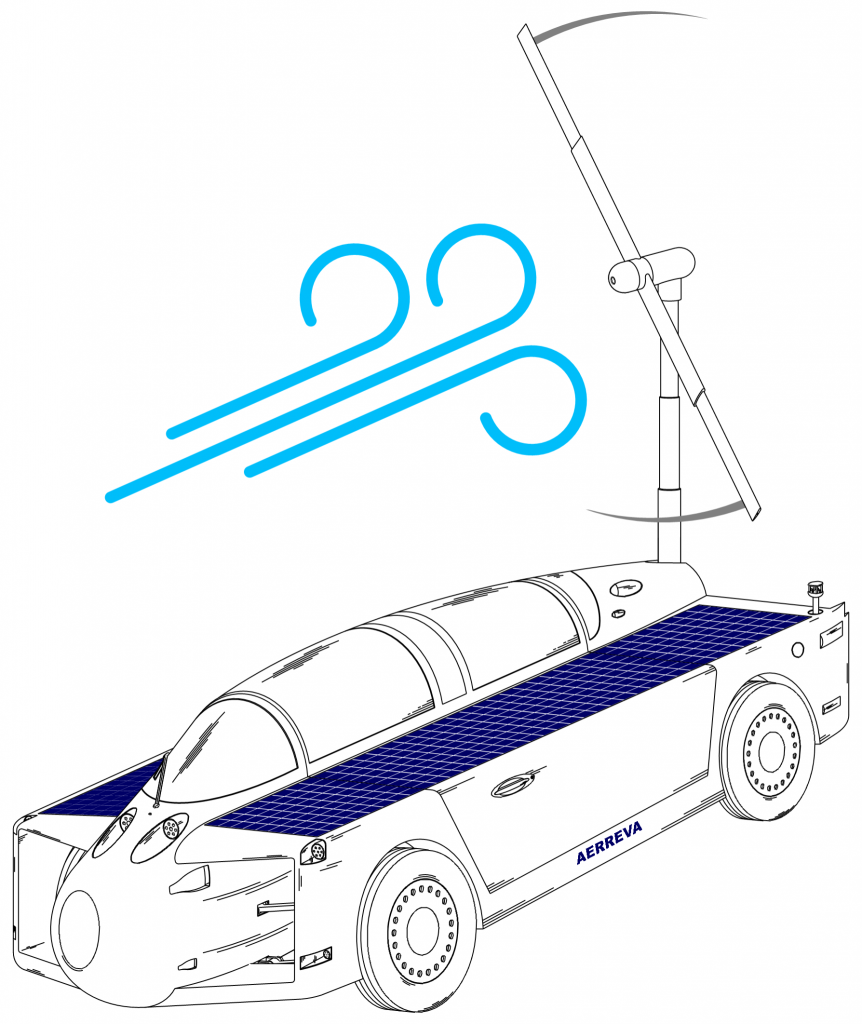
| Rotor Diameter | Wind Speed | Wind Speed |
| 6 feet | 15 mph -> 130 watts | 30 mph -> 1,169 watts |
| 9 feet | 15 mph -> 294 watts | 30 mph -> 2,640 watts |
| 11 feet | 15 mph -> 441 watts | 30 mph -> 3,950 watts |
Wind speeds of 20 mph or more in regions such as the Midwest and Great Plains can produce enough energy in 24 hours to power the EV for 500 miles, with even greater distances achievable in stronger winds. These mileage estimates are based on an energy consumption of approximately 6.714 kWh, or 122 watt-hours per mile, when traveling at 55 mph.
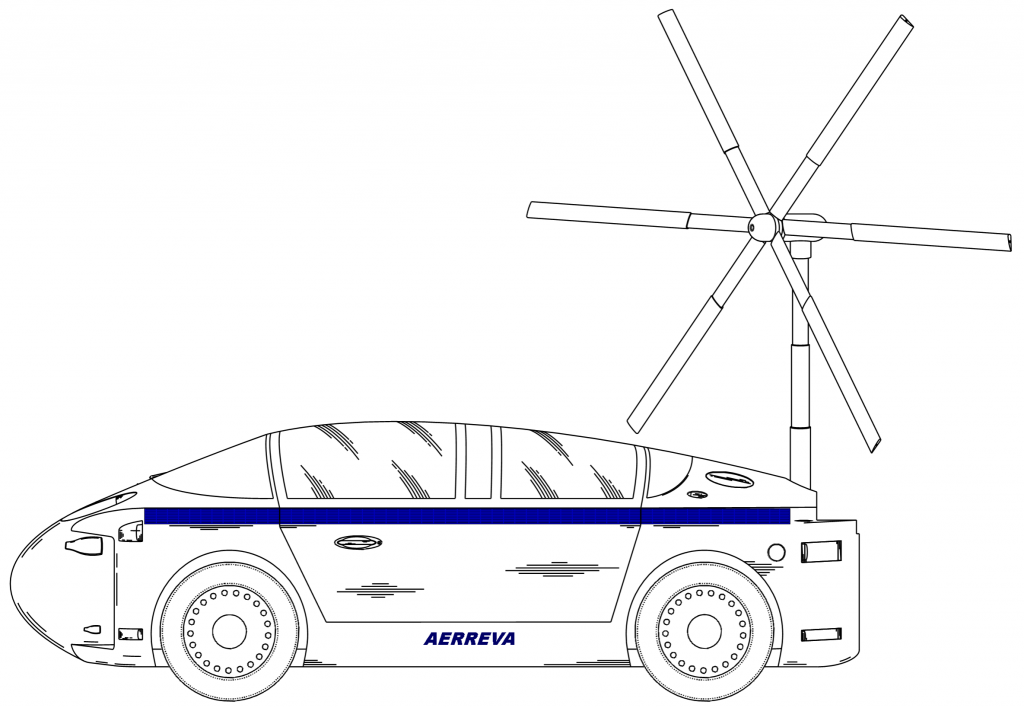
Solar Energy + Wind Energy
In a 30-day period, the solar panels and wind turbine can generate a total of 3,070 kWh of energy. This amount of energy is sufficient to charge an 80 kWh battery pack 39 times. For more information on renewable energy production, please visit our solar and wind energy pages.
Energy is Money
Net billing, or net metering, with AERREVA electric vehicles can help reduce a household’s electricity bills. Electricity rates vary by state; for example, Hawaii has one of the highest rates, averaging 46.52 cents per kilowatt-hour (kWh), while Nebraska charges around 10.58 cents per kWh. By combining energy output from solar and wind sources, it is possible to generate approximately 1,068 kWh of energy every month. This can yield renewable energy credits worth around $113.00 in Nebraska and $496.83 in Hawaii. As energy demand increases and the transition to more expensive energy sources occurs, electricity prices are projected to rise.
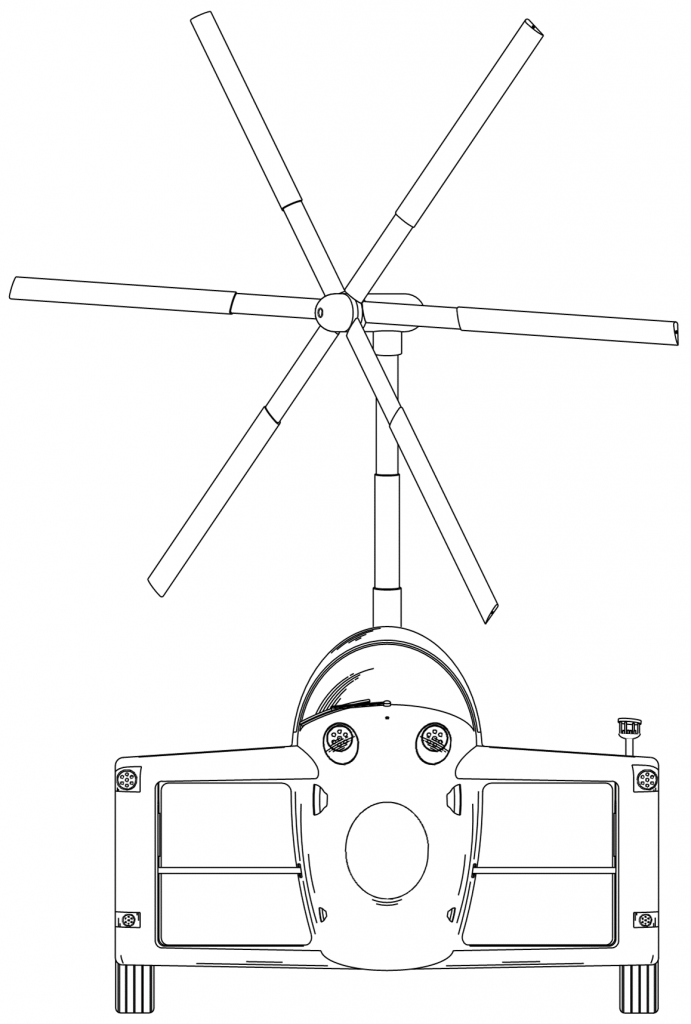
Nationwide Wind Energy Potential
Small wind turbines have the potential to generate substantial amounts of energy. For instance, one million turbines operating in 20 mph winds can produce 28 million kWh of electricity, enough to power nearly one million homes for 24 hours. When wind speeds increase to 30 mph, the same number of turbines could supply energy to four million homes. Even at lower wind speeds of 15 mph, these turbines can still generate 10 million kWh daily, which is sufficient to power half a million homes.
(28 kWh x 1,000,000 = 28,000,000 kWh) (20 mph winds/24 hours).
(94 kWh x 1,000,000 = 94,000,000 kWh) (30 mph winds/24 hours).
10,000,000 kWh (10 mph winds/24 hours).
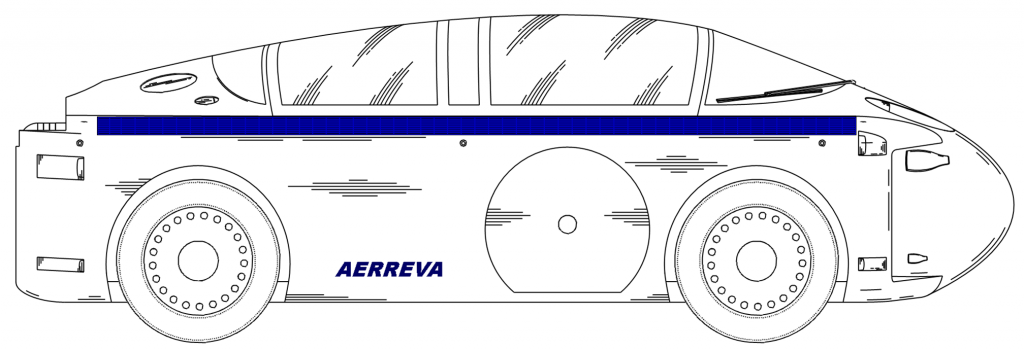
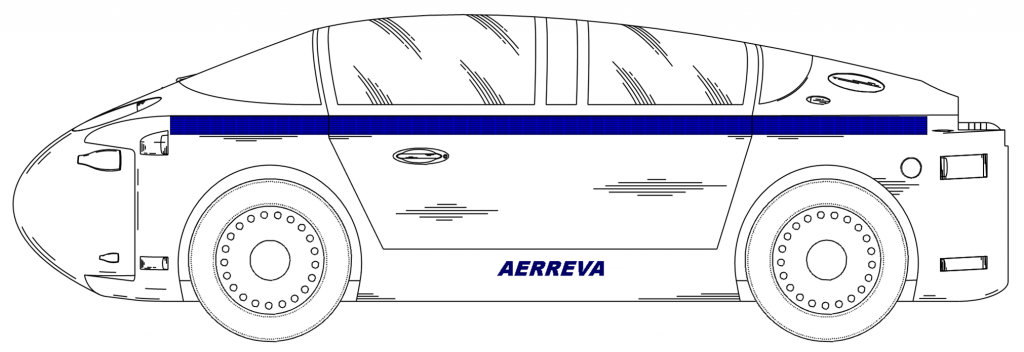
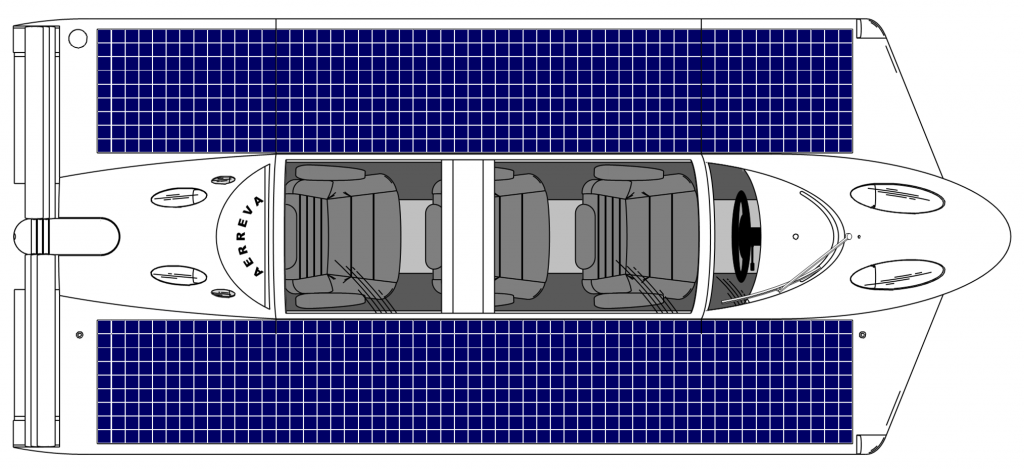
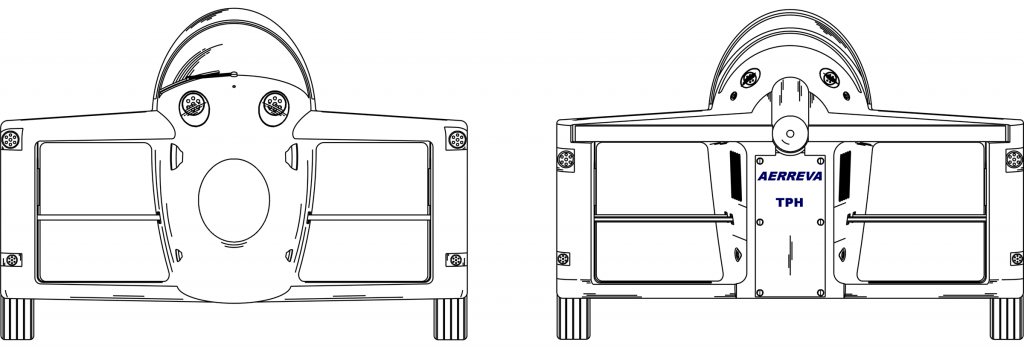
Energy Production Estimates
The estimates for solar and wind energy production did not take into account that an average car is parked approximately 95% of the time. Furthermore, the efficiency of converting DC to AC also has not been included in the estimate.
Development Stage
AERREVA H-Series EVs are currently in the early stages of development, from conceptual drawings to patent applications and prototypes. The next step is to build a functioning prototype. The vehicle and its wind and solar subsystems and methods are Patent Pending (Utility Patent Application) filed by DLA Piper LLP (US), a global company that provides intellectual property and patent services. They have been extremely helpful, providing information and guidance throughout the process.
Acknowledgments
The author acknowledges the National Aeronautics and Space Administration (NASA), the United States Environmental Protection Agency (EPA), the United States Department of Energy (DOE), the U.S. Energy Information Administration (EIA), and the National Renewable Energy Laboratory (NREL) for providing data.
Other AERREVA series
Currently in development are various AERREVA series and their variants. This includes a larger horizontal-axis wind turbine with a tower design, a larger solar array subsystem that can be attached to any variant, a new type of wind turbine that is more suitable for urban areas where wind direction changes frequently, and a wider cabin design for increased seating
LH – larger HAWT and tower.
LSP – larger solar array subsystem.
V Series – new type of wind turbine.
W Series – wider cabin.